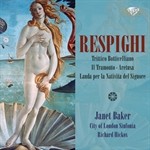
Trittico Botticelliano / Aretusa / Lauda per la Nativita del Signore / etc
 $20.00
Out of Stock
$20.00
Out of Stock6+ weeks add to cart
RESPIGHI
Trittico Botticelliano / Aretusa / Lauda per la Nativita del Signore / etc
Janet Baker (mezzo) / City of London Sinfonia / Rchard Hickox
[ Brilliant Classics / CD ]
Release Date: Thursday 1 April 2010
This item is currently out of stock. It may take 6 or more weeks to obtain from when you place your order as this is a specialist product.
Respighi studied orchestration with Rimsky Korsakov, another master of the orchestra, and his use of the orchestral palate was a huge influence on the young Italian.
Ottorino Respighi (1879-1936) is one of the great masters of orchestration. His vivid trilogy of symphonic poems The Pines of Rome, The Fountains of Rome and Roman Festivals are unrivalled in their vivid, pungent colours depicting the grandeur and savagery of ancient Rome. He studied orchestration with Rimsky Korsakov, another master of the orchestra, and his use of the orchestral palate was a huge influence on the young Italian.
Aretusa and Il Tramonto date from the 1920s, and are based on poems by Shelley. Respighi concentrates on the pictorial rather than the dramatic elements of the poetry, ornate melodic writing and colourful orchestration skilfully create the atmosphere.
Towards the end of his life, Respighi was increasingly drawn to religious subjects - either for operatic projects or concert pieces such as Lauda per la Nativita del Signore. Gregorian chant also preoccupied him at this time, and this work for three soloists and a small choir and wind instruments is a skilful blend of Gregorian sounds and a Monteverdian madrigal. The text is the Canticle of the Nativity by Jacopone da Todi, and could be termed an extended Christmas Carol.
Trittico Botticelliano was composed in 1927, and the inspiration came from the three famous paintings by Sandro Botticelliano - La Primavera, L'adorazione dei Magi and La nascita di Venere. The other famous composition taking art works as its inspiration is Mussorgsky's Pictures at an Exhibition, however the two composers approached the subject matter in very different ways. The Russian focussed on the dramatic elements of the paintings, whereas the Italian was drawn to the sensual nature of the images - bird song, gentle spring breezes in the fresh green leaves of trees, and the slow movement of the sea, waves and sea breezes. Masterfully scored, the music leaves a lasting impression on the listener.